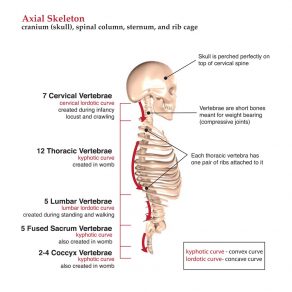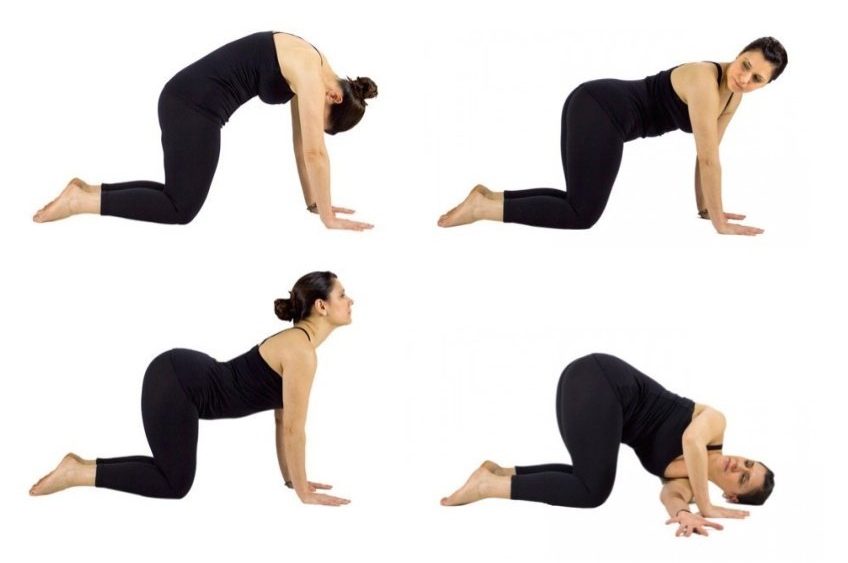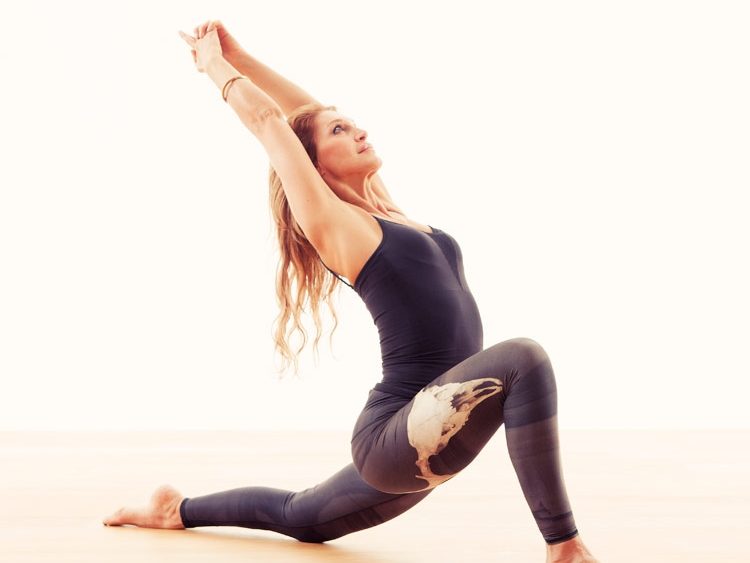What is so special, so important, about the 33 stacked bones in the center of your body and the muscles that support them that they warrant so much attention? Whether by spinal manipulation or core strengthening work, we will see that taking extra care to warm up and wake up the axis of your being will not only offer benefits on the physical level but on the more subtle psychological and energetic levels as well.
Let’s start our exploration at the very beginning
The nervous system – brain, spinal cord and nerves
While most organs are finished forming after 8 weeks in the womb, the spinal column (33 short/irregular weight-bearing bones that house the precious spinal cord of the nervous system) continues to grow and specialize well after. The spinal cord and the 31 pairs of spinal nerves play an important role in how we interact with the world around us:
- Motor nerves carry sensory input from the brain and spinal cord to other parts of our body – allowing for us to play, dance, fly into Bakasana and float back into Chaturanga Dandasana.
- Sensory nerves are the ones that relay information from external stimuli to the brain through the spinal cord.
The fantastic play between what we are able to sense from our environment and then our ability to react to it all is the beauty and the awe-inspiring intelligence of our nervous system. A strong and supple spine ensures not only the efficiency of this crucial system but also the health and longevity of it.
A strong and supple spine ensures not only the efficiency of the nervous system but also the health and longevity of it.
You are only as young and as healthy as your spine is strong and supple ~ Ancient yogi saying.
The Primary Curve
In our earliest stages of development, each of us spent much of our time in the fetal position. It is in the womb that the first curve of the spine was created. This natural convex curve is a kyphotic curve (visualize the entire length of your spine in a forward, rounded, flexed c-curve shape). As life force coursed through us, we moved out of our kyphotic curve to expand and twist into a myriad of shapes, only to return once again into the contracted fetal position. Awesome yogis that we were. This first curve of the spine owes itself to the many months spent in this symbolic shape of nourishment and safety, especially in the last month when space in the womb began to decrease. When movement was limited to the dedicated act and profound process of growing.
The Secondary Curves
The second curve of the spine, the natural lordotic curve (concave curvature) is created after our departure from our mother and our entry into the world. It has been said by some that the lordotic curve of the neck, the 7 cervical vertebrae, is first created by the hairpin turn at the exit of the birth canal. For those of us that never quite made that journey, it is the more common theory that the cervical lordotic curve is created by lifting our heads (whilst on our belly) to look around at our brand new surroundings. At this stage, a subtle lordotic curve also begins to form at the small of the back, the lumbar vertebrae. Let’s face it, babies are the most advanced yogis when it comes to Salabhasana.
The lifting of first the head, and later both head and legs, begins the process of reversing our natural born, entire-length-of-the-spine kyphotic curve. It is with the further developmental processes of crawling and standing that we see that the lordotic curves of the spine become more pronounced, both in the smallest cervical vertebrae and largest/thickest lumbar vertebrae of the spine.

Our longer/thinner thoracic vertebrae (12 spinal bones with a rib joint on either side), our sacrum (5 fused bones at the base of the spine) and our tiny coccyx vertebrae (2-4 fused “tail” bones) all remain in a natural kyphotic curve. So we end up with four natural curves of the spine, starting from the top: Cervical lordotic, Thoracic kyphotic, Lumbar lordotic and Sacrum/Coccyx kyphotic.
Your natural curves
An appreciation for, and an embodied wisdom, of the natural curves of your spine will dramatically affect the way you approach the fullness of each and every one of your yoga asanas as well as the habitual shapes you make off the mat while working and/or playing.
If you would take a moment to feel the back of your neck you will feel your cervical lordotic curve. Now, place one hand on the small of your back and feel your lumbar lordotic curve. These two curves mirror each other. If we tend to dump/compress the back of our neck in back bending postures we most likely are dumping/compressing the lower back as well. And vice versa. Notice this next time you inhale into your Adho Mukha Svanasana or inhale/exhale into your Ustrasana.
In the same vein, the kyphotic curves of your thoracic spine (where the back of the 12 pairs of ribs attach via ligaments) and your sacrum/coccyx also mirror each other. Unfortunately, many of us spend a lot of our daily lives in pronounced kyphotic curves of thoracic spine while working at a computer, driving, cycling, hiking, lounging while texting or gaming, even hunched over while eating. This leads to both tight and weak muscles that support the spinal column – usually tight pectorals and weak rhomboids (between shoulder blades), tight hip flexors, weak abdominals and tight/weak quadratus lumborum and other back extensors.
It is a daily necessity, especially for those developing chronic kyphotic patterning, to come to the mat and practice both arched (extension) and rounded (flexion) poses like Cow and Cat. To allow for deep, satisfying exploration of these four curves and the stretching/strengthening of the muscles on the front and the back of your core – from top to the bottom of your axial skeleton.
Are spinal curves the fountain of youth?
The curves alone are not what keeps us young and healthy but visualizing the curves, and feeling them on a visceral level, will allow for proper movement and manipulation of your spine. This in turns creates an optimum environment for the spinal cord housed within the column, and for the nerves that exit through the spaces between the vertebrae. A strong and supple spine not only protects your nervous system but allows for its utmost efficiency and longevity.
A strong and supple spine not only protects your nervous system but allows for its utmost efficiency and longevity.
One of the best things a human being can do for their nervous system is to manipulate the spinal column in three planes of movement. These being the 6 directions of flexion, extension, lateral extension right and left and twisting/revolving right and left.


